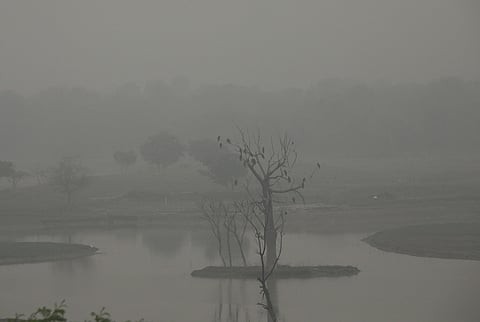




Disclaimer: Copyright infringement not intended.
A new species of snakehead named Channa nachi was recently discovered in Meghalaya.
|
Attribute |
Details |
|
Scientific Name |
Channa nachi |
|
Common Name |
Farham’s Snakehead and is proposed in honor of Farham Sangma |
|
Discovered By |
Farham Sangma a fish hobbyist from Meghalaya |
|
Habitat |
Shallow, slow-flowing stream near Chokpot village Part of the Simsang River system Substrate: Sand, leaf litter and pebbles |
|
Other Fish in Habitat |
Schistura reticulofasciata Dario kajal Pseudolaguvia sp. Barilius bendelisis |
|
Physical Characteristics |
Medium-sized snakehead Elongated, slender body Bicolor body: Anterior (creamish-yellow to pale-brown), Posterior (rich blue) Pale-blue marbling on the ventral area 10–12 pale brown saddles on the dorsal half No spots or blotches No transverse markings on the caudal fin |
|
Cultural Significance |
Named nachi after the vernacular Garo term for the fish Reflects the connection between the Garo people and their aquatic biodiversity |
|
Potential in Ornamental Trade |
Vibrant coloration makes it attractive for the international aquarium trade Joins other sought after species like Channa andrao, Channa bipuli and Channa aristoneifrom Northeast India |
|
Attribute |
Details |
|
Scientific Family |
Channidae |
|
Genera |
Channa (Asia) Parachanna (Africa) |
|
Number of Species |
Over 50 species |
|
Native Range |
Countries including China, India, Malaysia, Indonesia Tropical regions in Africa |
|
Physical Characteristics |
Ranges from 17 cm in smaller species to over 1 meter in larger ones Elongated with long dorsal fins Large mouth with sharp, canine-like teeth |
|
Unique Abilities |
Possess a suprabranchial organ allowing them to breathe air enabling survival in low-oxygen environments and facilitating movement across land for short distances Capable of walking short distances on land by wriggling their bodies |
|
Diet |
Juveniles feed on zooplankton, small insects and crustaceans Adults are predominantly piscivorous (fish-eating); also consume amphibians, crustaceans and occasionally small mammals |
|
Reproduction |
Many species exhibit nest-building behaviors and guard their offspring |
|
Habitat Preferences |
Prefer stagnant or slow-moving freshwater bodies like ponds, swamps and rivers with abundant vegetation; can tolerate a range of environmental conditions |
|
Invasive Concerns |
Some species, such as the Northern Snakehead (Channa argus) have been introduced to non-native regions leading to ecological concerns due to their predatory nature and competition with native species |
|
Economic and Cultural Significance |
Valued as a food source in many Asian countries; farmed extensively Believed to aid in wound healing and reduce postoperative pain in certain cultures Some species are popular in the aquarium trade due to their unique appearance and behaviors |
|
Conservation Status |
Varies among species; some are abundant while others like the recently rediscovered Chel snakehead (Channa amphibeus) are rare and were previously thought to be extinct |
Sources:
|
PRACTICE QUESTION Q. Which of the following recently discovered snakehead species are native to Northeast India?
Select the correct answer using the code below: Answer: b) Explanation: Channa striata is a widespread species found across South and Southeast Asia not a newly discovered species from Northeast India. |







© 2025 iasgyan. All right reserved